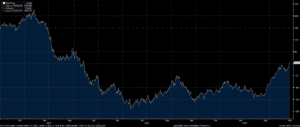
Will the real yield curve please stand up?
On the game show “To Tell the Truth”, we could find out in a 30-minute episode which of three contestants was being honest. Unfortunately, when it comes to the economy, things don’t tend to come together that quickly. While much focus has been placed on the difference between the two-year yield and the 10-year yield in the U.S. treasury market, Federal Reserve research has pointed to the relationship between the yield on the three-month treasury and the 10-year yield as an overall signal of economic growth and recession. And, for the first time since November 2022, that all important relationship finally ticked back into positive territory (See chart of the week below).
This marks another data point in the ongoing list of indicators of the resiliency of the U.S. economy as we prepare to turn the calendar to 2025. Additionally, small business optimism registered a significant increase as signs of life emerge in small-cap stocks with expectations for pro-growth policy from the incoming Trump Administration, which could bolster small businesses nationally.
This week brings the final, and all important, Federal Reserve meeting of 2024 with a 25-basis point cut expected. Many pundits expect three or four rate cuts in 2025 from the FOMC of between 100 to 125 basis points in the Fed Funds’ rate. Those expectations set up a pivotal tug of war between policy makers under a new administration versus inflationary trends that appear to be picking back up of their own accord without any further inflationary pressure in the form of potential tariffs. This tug of war could set the tone for 2025 should there need to be a repricing in policy expectations.
![]()
- U.S. Inflation – On a year-over-year basis, U.S. Headline CPI for November came in at 2.7% while Core CPI comes in at 3.3%.
- U.S. Small Business Optimism – Optimism came in at 101.7 off of an estimate of 95.3.
- European Rates – The European Central Bank cut rates by 25-basis points as expected and softened language related to keeping rates restrictive going forward.
![]()
U.S. Three-Month / 10-Year Spread Dis-Inverts
Source: Bloomberg









